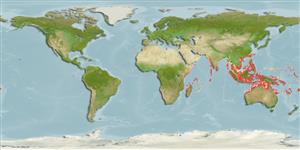Classification / Names
Common names from other countries
Main reference
Size / Weight / Age
Max length : 20.3 cm SL male/unsexed; (Ref. 3605); common length : 10.0 cm SL male/unsexed; (Ref. 188)
Environment
Marine; pelagic-neritic; amphidromous (Ref. 51243); depth range 0 - 50 m (Ref. 188)
Climate / Range
Tropical, preferred ?; 26°N - 23°S, 37°E - 179°W (Ref. 188)
Distribution
Indo-West Pacific: Gulf of Aden south to Madagascar and Mauritius and east to the Arabian Sea and northwestern India (apparently not found south of Bombay nor in northern Bay of Bengal); then from Indonesia (but not in South China Sea) to Samoa. Reported from the Penghu Islands (Ref. 55073).
Countries | FAO areas | Ecosystems | Occurrences | Introductions
Short description
Dorsal
spines
(total): 0;
Dorsal
soft rays
(total): 13-21;
Anal
spines: 0;
Anal
soft rays: 12 - 23. Body depth usually not much more than 30% of standard length; scutes 27 to 31. The jet black caudal tips distinguish S. melanura from all other species of Sardinella except S. atricauda (scutes 32 to 35), S. hualiensis (dark spot at dorsal fin origin, scales fimbriated and with small perforations) and S. fijiense (gill rakers 87 to 134).
IUCN Red List Status (Ref. 115185)
Threat to humans
Harmless
Human uses
Fisheries: minor commercial; bait: usually
More information
Common namesSynonymsMetabolismPredatorsEcotoxicologyReproductionMaturitySpawningFecundityEggsEgg development
ReferencesAquacultureAquaculture profileStrainsGeneticsAllele frequenciesHeritabilityDiseasesProcessingMass conversion
Tools
Special reports
Download XML
Internet sources
Estimates of some properties based on models
Phylogenetic diversity index
PD50 = 0.5000 many relatives (e.g. carps) 0.5 - 2.0 few relatives (e.g. lungfishes)
Trophic Level
2.8 ±0.3 se; Based on size and trophs of closest relatives
Resilience
High, minimum population doubling time less than 15 months (tmax=4; k >0.7)
Vulnerability
Low vulnerability (21 of 100)
Price category
